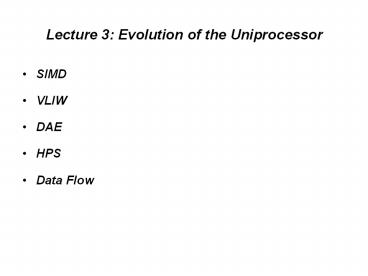Lecture 3: Evolution of the Uniprocessor - PowerPoint PPT Presentation
1 / 17
Title:
Lecture 3: Evolution of the Uniprocessor
Description:
Title: PowerPoint Presentation Last modified by: ECE-LRC Created Date: 1/1/1601 12:00:00 AM Document presentation format: On-screen Show (4:3) Other titles – PowerPoint PPT presentation
Number of Views:74
Avg rating:3.0/5.0
Title: Lecture 3: Evolution of the Uniprocessor
1
Lecture 3 Evolution of the Uniprocessor
- SIMD
- VLIW
- DAE
- HPS
- Data Flow
2
(No Transcript)
3
(No Transcript)
4
(No Transcript)
5
(No Transcript)
6
The HPS Paradigm
- Incorporated the following
- Aggressive branch prediction
- Speculative execution
- Wide issue
- Out-of-order execution
- In-order retirement
- First published in Micro-18 (1985)
- Patt, Hwu, Shebanow Introduction to HPS
- Patt, Melvin, Hwu, Shebanow Critical issues
7
(No Transcript)
8
(No Transcript)
9
(No Transcript)
10
(No Transcript)
11
- The final flexibility Data Flow
12
(No Transcript)
13
(No Transcript)
14
(No Transcript)
15
Characteristics of Data Flow
- Data Driven execution of inst-level Graphical
code - Nodes are operators
- Arcs are I/O
- Only REAL dependencies constrain processing
- Anti-dependencies dont (write-after-read)
- Output dependencies dont (write-after-write)
- NO sequential I-stream (No program counter)
- Operations execute ASYNCHRONOUSLY
- Instructions do not reference memory
- (at least memory as we understand it)
- Execution is triggered by presence of data
16
- Why Data Flow?
- Irregular Parallelism
- Only real dependencies constrain
- Anti-dependencies dont
- Sequential I-stream doesnt (No Program Counter)
- Asynchronous (NOT in the sense of un-clocked)
- Why NOT Data Flow?
- In one word too much architectural state
17
Specific Problems with Data Flow
- Code bloat (everything is explicit)
- Code debug (asynchronous, non-deterministic flow)
- Interrupt handling (providing a consistent state)
- Machine diagnosis (trouble-shooting design
errors) - Recursion
- Large data structures
- Node table overflow (cost of CAM is high)
- Performance caveats
- Array copy operations
- Long latencies
- Network (bypass paths) congestion































